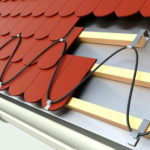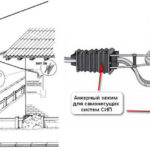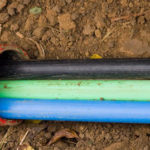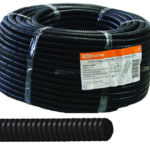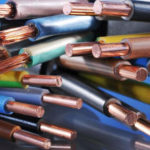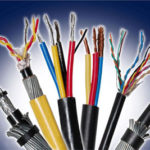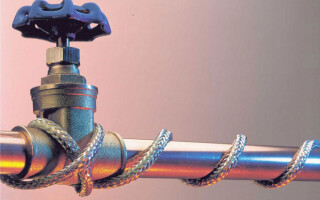Pipes laid underground are constantly under the influence of low temperatures. To during the winter frosts the water supply does not fail along the communications lay a heating system. Installation of heating cable for water pipes with their own hands to do is not difficult if you follow all the instructions.
Contents
Why heating cables are needed
Some people think that if you lay the pipes at a sufficient depth, you do not need the cable. The ground temperature at a depth of 1.5-1.7 m is +2 ... -4°C, and if you insulate the water or sewage system, they will not freeze. However, the functional properties of the pipes will be impaired if the area is boggy or located near a body of water, as during the melting of snow they will be constantly flooded with water. With a heating system and proper thermal insulation, pipes can be laid to a depth of 0.5 m.
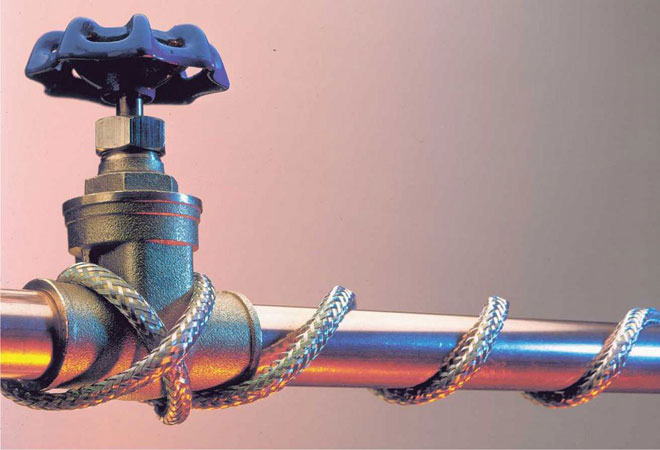
Design and applications
The principle of operation of the cable is to generate heat by converting it from electricity. The cable receives electricity and transmits it to the pipe, thus preventing the liquid inside from freezing. Pipe freeze protection is divided into several types, which are designed for heating not only water and sewage pipes, but also for gutters and tanks. They have different technical characteristics and are used outside the pipes and underground. Design features of the cable:
- The cable consists of one or more wires that are inside it. They are made of alloys with high resistance to electric current. The amount of specific heat depends on this parameter. The higher the resistance, the greater it is.
- The inner core is protected by a polymer sheath and an aluminum shield. Sometimes it is braided with copper wire.
- All internal parts are covered by an outer sheath. It is made of durable PVC material, which has water-resistant properties and is not destroyed by ultraviolet rays.

Depending on the manufacturer, the composition of the cable may vary.
Types of heating cable for water pipes
Heating cable is divided into 2 types, each of which is used in different areas. It can be self-regulating or resistive. Self-regulating model is used on long water pipes. Short pipes with a cross section of not more than 40 mm in diameter are heated with resistive models.
Resistive
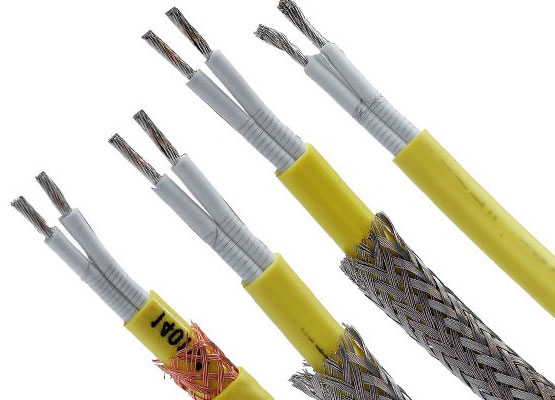
The cable works according to the following connection scheme: current passes through the inner cores of the wire and heats it, releasing a large amount of heat. The high heat output is due to the high resistance and maximum amperage. You can buy a wire that gives off heat along its entire length in equal proportions. These models have a constant resistance. What you need to know when wiring a wire:
- Single-wire. To heat a roof gutter or arrange a warm floor, use a heating circuit of the "closed" type. Single-core wires are used for this purpose. Connecting a single core wire is similar to a loop. The wire is wrapped around the pipe, and its ends are connected to electricity. To insulate the water pipe, an external type of connection is used and the wire is laid on either side of it.
- Double-wire. If it is necessary to make an internal laying, then a two-core wire is used. It consists of two wires: heating and supplying energy. The wire is laid along the water pipe, connecting one end to the electricity. With the help of tees and grommets, two-core wires can be laid inside a pipe.
It is an inexpensive, reliable wire that has a long service life (15 years). Its disadvantages: the standard length, the power is always the same and it cannot be adjusted. Because of one blown section you will have to change the whole cable. If 2 cables are near each other or overlap, they will burn out. By installing a thermostat with sensors, the system will turn itself off and on. The power will turn off if the temperature reaches +7°C. If it drops to +2°C, the heating will automatically turn on.
Self-regulating
Multifunctional self-regulating cable is used for sewer lines, water systems and roof heating. Its functionality - the amount of heat supplied and the power level are self-regulating. The wire heats itself after the temperature reaches a reference point. If you compare it with its resistive counterpart, the insulation layers of the wires are the same, but the heating matrix is different. Principle of operation:
- Depending on the resistance of the self-regulating cable, the conductor is able to change the amperage downward or upward.
- When the resistance increases, the amperage begins to decrease, thereby minimizing the power.
- As the wire cools, the resistance decreases. The amperage increases, triggering the heating process.
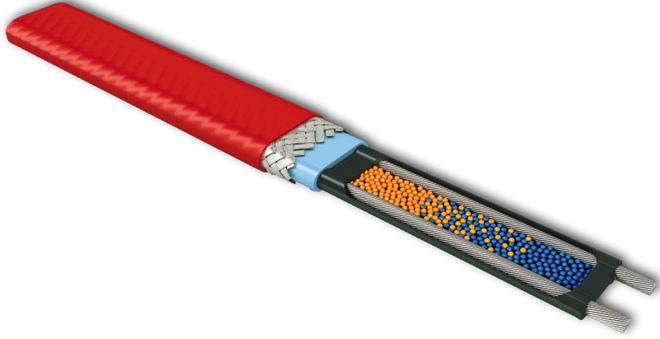
If you automate the system with a thermostat, depending on the temperature conditions outside, it will independently control the process of switching on and off.
The main technical characteristics when selecting
The choice of the maximum length of self-regulating cable depends on the size of the area to be heated and the diameter of the pipes. Also take into account the maximum temperature to which the ground is frozen. How much electricity the heating cable consumes, it depends on its power and to what temperature it is heated. The power of the heating cable is chosen depending on the diameter of the pipe. Products with a wattage of 10 W/m are used for pipes up to 2.5 cm in diameter. Pipes with a diameter of 2.5-4 cm are heated with 16 W/m models. Models with 24 W/m are designed for pipes with a diameter of 4-6 cm. When buying a cable, consider:
- power of the product;
- temperature class;
- type of outer insulation;
- equipment with protective braid;
- manufacturer.
Products of foreign companies Devi, Nelson, Raychem and Ensto are very popular. Products of the Russian company SST (Teplolyuks) have also proven to be popular.
Ways of installation
There are two ways of heating cable laying. The outside method is to wrap it around the pipe or lay it along the pipe. Internal - the wire is wound inside the pipe to prevent the water pipe from freezing. Connection of the heating cable is made according to the wiring diagram.
Linear installation
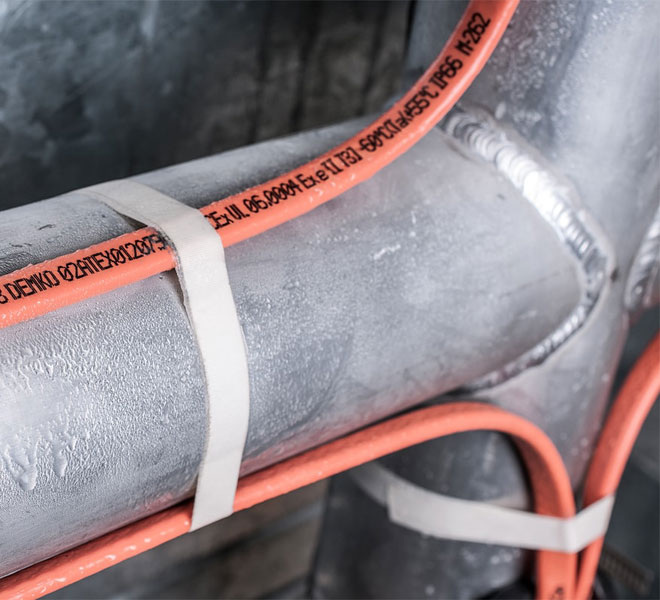
When installing the heating cable in a linear way, fixation is done with the help of plastic or fiberglass holders. They are installed at intervals of 0.3 m from each other. Metal fasteners are not used. If the pipes are in the ground, the location of the wire is done with a slight offset. It is impossible to lay it evenly at the bottom or at the top.
Spiral installation
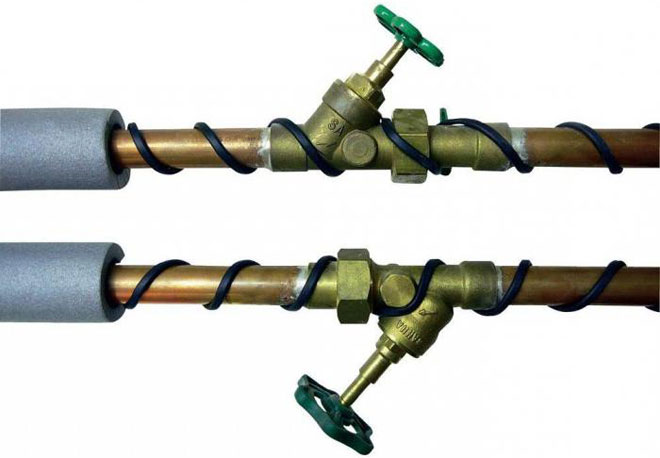
For pipes of medium and large diameter, spiral mounting is used. The wire is wound on the pipe with turns at regular intervals. The interval of turns is reduced if any part of the pipe is severely frozen. Although this installation requires a large consumption of material, but it ensures maximum contact between the pipe and the wire.
Internal installation
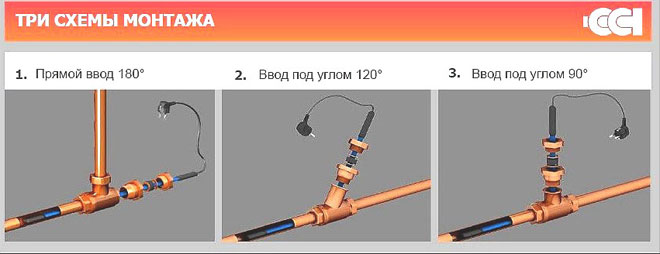
Installing a heating cable for indoor plumbing is only suitable for short pipes greater than 0.4 cm in diameter. The wire will obstruct the flow of water if installed in a smaller diameter pipe. It will also be difficult to make an installation in a long length of water pipe. In pipes with a vertical arrangement, the wire is pulled through with a tee and a sealing sleeve.
How to connect to the network and test
Heating cable connection is made to the network with a voltage of 220 volts. This is done using a cold lead. It consists of 3 stranded wires and a plug. Before you connect the self-regulating heating cable, it must be laid and carefully secured. Wiring process:
- To bare the braid, 70 mm of outer insulation is removed from the tip of the wire.
- The braid is uncoiled and twisted in a bundle, then bent to the side.
- To bare the wire, 30 mm of the inner insulation is removed.
- To find the cores, the heating semiconductor matrix is trimmed slightly, heated and removed. A hair dryer can be used for heating.
- At the end of the heating wire and the harness, sleeves are fixed. They are crimped. Each wire is insulated and secured with heat.
- A heat shrink is put on to close the end of the inner insulation. It is clamped with pliers after it heats up and shrinks. To separate the wires, it is pressed in the middle.
- A large heat shrink is put on the power cord. A small size heat shrink is put on each wire individually.
- Insert the wire ends of the power cord into the crimp sleeves and crimp them. A heat shrink is put on the bare wire with the thermowell and heated.
- Earthing is made on the same principle and connected to the braid.
- A large heat shrink sleeve, previously put on the wire, is pushed over the connecting part and fixed.
Use the ohmic resistance measurement to check the resistive cable for proper operation. The final measurement should match the passport data. A small error is allowed. The connection of the self-regulating heating cable is checked by connecting it to the mains. If the connection has been made correctly, it will begin to heat. Another way to check - by measuring the current. Its values should correspond to the specifications of this model.
Related articles:
